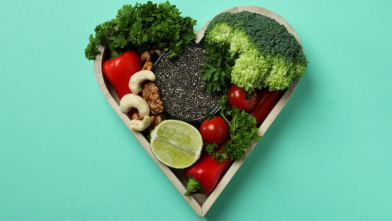People of all ages love pizza! It can be a tasty, quick, and cost-effective choice for a meal or snack. But pizza can contain a lot of carbs, sodium, fat, and may not offer a full serving of protein.
Follow these six tips the next time you’re shopping for frozen pizzas to make a choice that can fit into your eating plan.
Tips for Buying Frozen Pizzas
1. Read the Nutrition Facts label. This will tell you the amount of each nutrient (the healthy and the not-as-healthy) in the pizza as well as the serving size. From there, you can see how it might impact your blood glucose (blood sugar levels). Check for:
- Carbs: Carbohydrates (carbs) impact your blood glucose the most. The amount of carbs you should eat each day is different from person to person, so when looking at frozen pizzas, remember that only one quarter of the Diabetes Plate is filled with carbohydrate.
- Sodium: Frozen pizzas tend to have high amounts of sodium—even more when the pizza has processed meats, like pepperoni and sausage. Compare nutrition labels to find the pizza with the lowest sodium. The American Diabetes Association recommends consuming less than 2,300 milligrams of sodium per day. Try to choose foods that have less than 5% of the daily value of sodium listed on the food label and no more than 20%.
- Fats: Some fats are better for you than others. Look for pizzas that have lower amounts of trans and saturated fats by comparing the nutrition facts label. Like sodium, processed meats tend to have high amounts of the fats you want to avoid. Cheese also contains fat so be cautious of using a pizza with extra cheese. When reading the nutrition label, try to keep the saturated fat level to less than 10% of the daily value.
- Calories: Look for a pizza that has the fewest calories while offering the most nutrients you want, like protein and fiber.
- Portion size: The portion size tells you how many slices or how much of the pizza is represented on the nutrition label. For example, a nutrition label may say the pizza contains 100 calories with a serving size of one slice. If you have two slices, you will be eating 200 calories, 300 calories for three slices, and so on. You’ll have to increase the other nutrients too for each additional serving you have. If you’re feeling hungry, look for a pizza that has a higher serving size. But remain mindful of how many nutrients it has that you want to avoid.
2. Veg out! Non-starchy vegetables should take up the most space on your Diabetes Plate and on your frozen pizzas. Compare brands to find the pizza with the most veggies—that include veggies used in the crust, like cauliflower or a mixture of cauliflower, broccoli, cabbage, carrots and kale, as well as the toppings! Better yet, add more veggies to your pizza whether it’s homemade or a frozen pizza. Think about adding typical pizza toppings like mushrooms, onions, peppers, and others you don’t usually see like chopped broccoli, artichoke hearts, or chopped kale or spinach.
3. Have a salad on the side. By adding a side salad full of fresh leafy greens and vegetables, you’ll add fiber and antioxidants to your meal. Top the salad with an olive oil vinaigrette for heart-healthy fats.
4. Power-up with protein. Protein in our meals helps us feel full and satisfied for longer while giving us energy. Look for pizzas that are either labeled an “excellent” (at least 20% daily value) or “good” (at least 10–15% daily value) source of protein. Even though processed meats are a source of protein, try to use other sources like chicken to top your pizza where possible.
5. Build your own pizza using a premade crust. Look for different types of premade crust at your grocery store. These are ready for you to add your own sauce, cheese, and toppings. This is an easy way to control what’s on your pizza to limit sodium and saturated fat while increasing the non-starchy vegetables.
6. Make your own pizza. Be creative with your cooking skills and look for diabetes-friendly pizza recipes. You may also want to try these recipes from Diabetes Food Hub BBQ Chicken Pizza—or use whole wheat pita as your pizza base.
Do What’s Best for You
As a reminder, everyone with diabetes has different nutritional needs. Talk to a registered dietitian nutritionist or diabetes care and education specialist about the amount of carbs, sodium, fat, and calories you should be eating to meet your health goals.
Be sure to check out all the recipes on Diabetes Food Hub and create an account so you can save recipes to try later.








